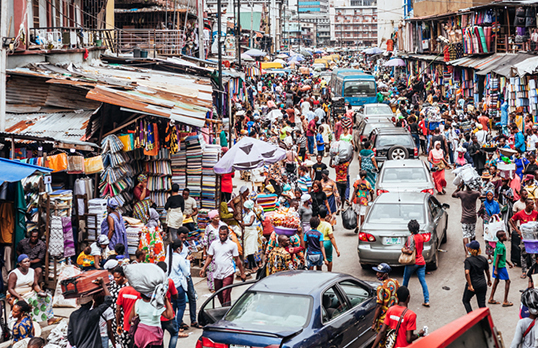In the day-to-day practice of architecture, thinking about economics is most often restricted to the financing of projects: are the economic conditions right for clients to get the funding they need for well-designed projects?
The second theme in the RIBA Horizons 2034 programme, The Economics of the Built Environment, invites a deeper consideration of the global economic system and architects’ part in it.
How is wealth created, owned, distributed and spent, and by whom? Who has the wealth now, and how did they get it? What are they using it for? What effects does the way that money is spent have on those with very little of it? Who gets to commission buildings, and for what purpose? Is the urban form, and the buildings within it, as much an expression of economic forces as it is an expression of design and client choice?
Looking deeper still, are economic forces themselves a manifestation of ideology? During the 1980s, Ronald Reagan and Margaret Thatcher turned the tide on the public sector spending of the postwar years with a zealous enthusiasm for privatisation and new public management, which took a private sector approach to delivering public services. In the 1990s, through policy transfer, governments globally jumped on the political and economic privatisation bandwagon. This has had a profound and lasting impact on the way that governments worldwide delivered many policies – including, for example, housing policy.
So, might client requirements and their resolution in design be helpfully understood not only as expressions of aesthetics and creativity but also as the results of economic and ideological imperatives, sometimes unseen and unacknowledged? And can these considerations inform architects’ future choice of how to practice, including what buildings to design, for whom, and where?
The economics of the built environment theme breaks down into four topics: interconnectedness and specialisation, emerging economies, inequality, and the financialisaton of the built environment. These topics are, together, likely to drive changes in the economics of the built environment over the next decade to 2034.
Powerful economic drivers
Since the establishment of ancient civilisations, cities have been synonymous with economic, cultural and human prosperity. Whether cities in the future are to remain productive, liveable and sustainable will ultimately be determined, in large part, by the shape of the built environment.
To date, across history and around the world, there is abundant evidence that urbanisation is one of the most powerful driving forces to shift entire generations from poverty to prosperity. [1] The power of cities lies in their density and in a built environment that drives interconnectedness and specialisation.For the private sector, this means that firms are closer to a wide and diverse pool of labour, critical for productivity. It also ensures that firms are well networked, allowing them to specialise because they can rely on other firms around them for other specialised inputs into production.
Cities also ensure that firms are close to markets – locally, nationally, regionally, and globally – by developing infrastructure that provides avenues for trade. The same density that drives productivity in the private sector also brings people closer together, so spurring new ideas and innovation.
These drivers of economic growth are the same ones that Adam Smith described in his seminal work, The Wealth of Nations, first published in 1776. This is why economists emphasise that cities can become key engines for growth. This should be encouraging for many emerging economies, which are currently some of the most rapidly urbanising places in the world. For example, due to high population growth, the number of people living in African cities is set to triple between 2024 and 2050.
This has huge implications for the built environment in these places: based on current projections, the urban footprint of Africa is set to expand by more than three times in the same period. [2]
As much of East Asia’s urbanisation trajectory has shown, the expansion of the built environment needs to be carefully managed. Where this does not happen, urbanisation results in sprawling, disconnected urban spaces characterised by unmanageable density in the form of congestion, insecurity of tenure and the proliferation of informal settlements.
Cities that do not invest enough in infrastructure fail to attract businesses and the rapidly growing youth population – such as those under 35 years – struggle to find employment, ultimately driving the growth of informal work. Even China’s built environment, which, has experienced one of the highest rates of expansion in the world, is experiencing an economic slowdown as its population ages and urbanisation slows, leaving broader questions about how to make urbanisation-led growth sustainable.
UN Sustainable Development Goal 11 codifies the global aspiration to “make cities and human settlements inclusive, safe, resilient and sustainable”. [3] Its first target is to “ensure access for all to adequate, safe and affordable housing and basic services and upgrade slums by 2030”. Distressingly, it is one of the few targets that has gone backwards. [4] Across the world, the urban environment is failing its inhabitants.
UN-HABITAT and the Office of the High Commissioner for Human Rights define adequate housing by seven criteria [5]:
- security of tenure
- availability of services, materials, facilities, and infrastructure
- affordability
- habitability
- accessibility
- location
- cultural adequacy
Ensuring a sufficient supply of affordable housing, a key determinant of liveability and productivity, has become a central challenge for built environment professionals.
How housing is produced and where it is located is a substantial driver of inequality. [6] In high-income housing markets, developers are highly incentivised to respond to the demand from their clients to ensure that housing is of good quality and well-located. However, poorer, more vulnerable communities are more tied to what they can afford, often having to forgo most of the other measures of adequacy. For example, many social housing projects are being built further and further from city centres, and thus are far from economic opportunities.
Inequality has been exacerbated by the financialisation of urban land and housing markets since the 1980s. Pioneered in the UK and the US and created by the globalisation and the associated liberalisation of capital markets [7], financialisation is resulting in the current global affordable housing crisis, as experienced in Europe, the UK, the US, and many other parts of the world. Accelerated by technological innovations, banks and other large lending institutions have not only entered but now dominate finance in the built environment – including in housing. [8]
Land and housing have both substantially appreciated in value over the past decades, becoming the preferred form of collateral. As a result, housing no longer functions just as a home but also as an asset that provides a store of value. As finance-stimulated demand rapidly increases, so too does price, particularly for well-located properties.
A future-focused, intersectoral response
Continuing business as usual is not an option. Not only will it fail to serve our communities, especially the poor and most vulnerable, but it will also fail to address the climate crisis. Currently, cities are responsible for over 70% of emissions globally, and with so many needing to be built to meet projected population growth, continuing at this rate is unsustainable.
The built environment professions must innovate urgently to match the dynamism and pace of change in cities. The approaches adopted must be tailored to their context. What works in regions with ageing populations, such as Europe, are likely to be different compared to what works in regions with a much younger workforce, such as in Africa and Asia. Other changes will also need to be accounted for. In the US, for example, built environment professionals must acknowledge the impact of working from home. [9]
Importantly, none of this innovation can be done in isolation. We need an intersectoral response by architects and planners, working closely with economists, engineers, sociologists, and others, to come up with solutions that unlock the potential of the built environment globally. Doing so successfully will have positive repercussions not only for current populations but for many generations to come.
References
[1] E. Glaeser (2012). Triumph of the City: how urban spaces make us human. Pan
[2] Marron Institute of Urban Management and Stern School of Business (n.d.). Atlas of Urban Expansion
[3] United Nations - Department of Economic and Social Affairs (n.d.). Sustainable Development Goal 11
[4] United Nations - Department of Economic and Social Affairs (2023) The Sustainable Development Goals Report: Special edition
[5] Office of the United Nations High Commissioner for Human Rights and UN-Habitat - United Nations Special Rapporteur on Adequate Housing in UN-Habitat and the Office of the United Nations High Commissioner for Human Rights (2009). The Right to Adequate Housing. (Fact Sheet 21/Rev 1)
[6] R. Rolnik (2019). Urban Warfare: Housing under the empire of finance. Verso
[7] J. Ryan-Collins, T. Lloyd, and L. Macfarlane (2017). Rethinking the Economics of Land and Housing. Zed Books
[8] T. Piketty, Thomas (2014). Capital in the twenty-first century. The Belknap Press of Harvard University Press
[9] E. Glaeser and D. Cutler (2021). Survival of the City: The Future of Urban Lief in an Age of Isolation. Penguin Press
About the author
Astrid R.N. Haas is an independent urban economist working across research and practice, supporting cities in Africa, the Middle East and Asia with questions of strategy related to financing and funding. She also has appointments as Adjunct Professor at the School of Cities, University of Toronto, Research Associate at both ODI and the African Centre for Cities at the University of Cape Town, and Extraordinary Lecturer at the African Tax Institute at the University of Pretoria.
Her previous engagements include working as an urban economist with the African Development Bank and as Policy Director at the International Growth Centre. She holds an MSc in Public Financial Management from SOAS, University of London and an MA in International Economics and International Development from Johns Hopkins University.












